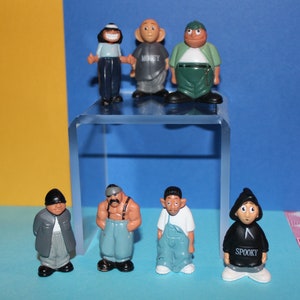
Some schools banned Homies, and a few retailers, including Vallarta Supermarkets in Los Angeles County, stopped carrying the toys. There are even a few Homies collectors in Scandinavia.īack in 1999, when Homies were new on the scene, the Los Angeles Police Department was afraid that children were the ones buying the toys, and claimed that the Homies were clearly designed to glorify gang members.

They are sold not just in California and New York, but Utah, Washington, North Carolina, Iowa, and Ohio, a state about as Latino as Scandinavia.
LIL HOMIES TOYS SERIES
Four series of Homies have come out since, totaling over 100 characters. A million Homies sold in four short months. In 1998 the first series of Homies figurines–Eight Ball, Smiley, Big Loco, Droopy, Sapo, and Mr. Hollywood and his friends Smiley, Pelon, and Bobby Loco starred in what became the original Homies comic strip, which ran as a regular feature in Lowrider magazine. Homies can be traced to Gonzales’ in-class high school doodles, where he drew a cartoon version of himself in the comic strip “The Adventures of Chico Loco,” later renamed “The Adventures of Hollywood,” after Gonzales’ nickname. Gonzales’ company, Gonzales Graphics, has been producing lowrider-, Aztec-, and religious-inspired stickers and T-shirts for well over a decade and is widely recognized as a pioneer business in the lowrider industry. We have artist and Homies creator David Gonzales, a Richmond native, to thank. But unlike the blatant fantasy element implicit in most toy figurine series, Homies take their cue from reality and depict a cultural identity in a manner that’s both vibrant and controversial. They’ve become an underground phenomenon–and a gigantic cash cow–selling millions of figurines and spawning a whole family of tie-ins. Hipster adults in their 20s have taken to collecting Homies just as much as kids have. Homies have a curious position in the toy industry.

People tend to love them or hate them, or not be aware that they exist. Homies can be spotted on eBay, in Snoop Dogg’s video for “From tha Chuuuch to da Palace,” and in vending machines across the country. The playful 3D thumbnail sketches of Chicano lowrider culture have become quite a presence since their debut. What parent, after all, would want his or her child playing with Payday, who wears a gold dollar-sign medallion, smokes a cigar, and has cash sticking out of his pockets? Or Wino, a rumpled Homie in a stocking cap who clutches a bottle of cheap wine in a paper bag? Detractors see Homies as itsy-bitsy toys that glamorize gang lifestyle. Since their arrival in 1998, Homies–plastic figurines under two inches tall–have drawn criticism for their decidedly urban, inner-city Latino look. There’s a whole barrio in there, and one by one, they funnel out of the vending machine’s opening at the drop of two quarters. Zoot suits, trench coats, baggy pants, basketball jerseys, leather jackets–their attire is as varied as their facial expressions. Some of the characters are grimacing and beefy, like linebackers others are grinning, thin, and wily. The vending machine in the middle holds G’d out B-boys, scantily-clad fly girls, pit bulls wearing sunglasses, and policemen eating donuts, all piled up on top of each other, encased in plastic bubbles. The candy in these machines is bright, monochromatic, and simple.
LIL HOMIES TOYS FULL
The vending machine to the left is full of gumballs in the shape of watermelons the one to the right hawks grape jawbreakers. With Homies, gangsta is in the eye of the beholder “Willie rolls on a customized Lowrider wheelchair that the Homies chipped in and bought for him,” explains Where the Heart Is


is an ex-gangster who works as a handicapped-youth counselor. Life Lessons: According to Homies lore, Willie G.


 0 kommentar(er)
0 kommentar(er)
